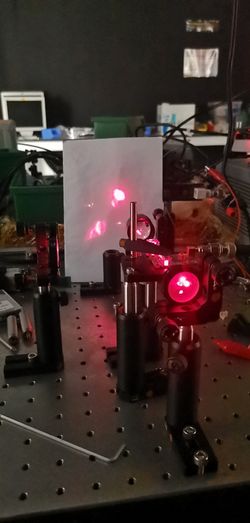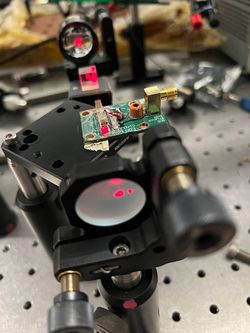Homodyne detection
Introduction
Optical homodyne detection is a method for detecting messages transmitted in optical signals, where a frequency or phase modulated signal is compared to what is misleadingly called the "local oscillator" (LO) signal, which is generated from the same source but not modulated with the message. In order to probe quantum effects, it is important to bring the noise of the detector down to the shot-noise limit, where the only fluctuations observed arise from the discrete nature of photons, which can be theoretically modelled as the vacuum-state fluctuations of the quantised electromagnetic field. This project's first objective is to build a homodyne detector from scratch.
Lab Location: S11-02-04 (Optics Lab)
Application: Continuous-variable QKD with Gaussian modulation and coherent states
While the first protocols for quantum key distribution (QKD) involved discrete variables (DV) in finite, small dimensions, QKD can also be done using continuous variables (CV) in infinite dimensions, i.e. the state of an electromagnetic field. Using Gaussian modulation and coherent states makes the QKD system relatively easy to implement and analyse, although getting positive key rates is a different matter. The homodyne detector is an essential component of this setup, but if we have the capacity, we can try to develop other parts of the system, such as the implementation of the QKD protocol itself in software. We want to pay particular attention to the design of the amplifier for the homodyne detector, for which there are stringent requirements and difficult tradeoffs to make.
Reality
What we actually ended up working towards is a simple version of the system proposed above. Instead of building a system capable of sending useful information, we aimed for the simpler objective of just being able to produce some kind of phase modulation. This is a stepping stone towards a full-blown optical communication system, where digital data is modulated onto the laser by a computer and read off from the results of the homodyne detection.
Background Reading
Our primary source of background information is Lasers and Electro-Optics, available for download via NUS Library. The relevant chapters are:
- Chapter 5 Laser Radiation, discussing the basic background on lasers
- Chapter 18 The Electro-optic and Acousto-optic Effects and Modulation of Light Beams, discussing how modulation can be achieved
- Chapter 21 Detection of Optical Radiation, discusses noise in detectors and the process of homodyne detection
For DV-QKD theorists who stumbled into this (like me), here's some background reading on CV-QKD:
- Review of Gaussian quantum-information processing
- Self-contained tutorial on theory of Gaussian-modulated CV-QKD
Tragically, we were nowhere close to being able to use the material on CV-QKD, but we leave the references here for posterity.
Theory
The Michelson Interferometer
Gaussian Beams
Misaligned Mirrors
Phase Modulation
The next question is how to vary in an easily controllable manner. TODO
Talk about LiNbO3 structure, birefringence, electro-optic effect
Noise
Finally, we have to control for the effect of noise in our experiment. There are four primary sources of noise in semiconductor photodetectors:
- Shot noise, or quantum noise, arising from the quantisation of light: because the light must arrive at the detector one photon at a time, there will be some fluctuation in the signal read at any point in time.
- Nyquist-Johnson noise or thermal noise, arising from thermal fluctuations in the electronics.
- noise, which is apparently a very mysterious and universal phenomenon caused by various different factors, but has a power spectral density proportional to , hence the name.
- Generation-recombination (GR) noise, caused by holes and electrons randomly being generated and recombining in the semiconductor.
is the sampling bandwidth, related to how often we take electrical measurements. By Nyquist's theorem, we must have a sampling period to reconstruct a modulated signal of maximum frequency component : that is, we must have .
Setup & Methodology

Homodyne Detection Setup
The overview for the initially intended experiment is:
- Split the laser beam into two, one component will be LO and another will be the signal
- Frequency-shift the signal beam using an acousto-optical modulator (AOM)
- Phase-modulate the signal beam using an electro-optical modulator (EOM). This is typically a crystal, whose birefringence is controlled by the voltage applied to it. For more advanced applications, we can use a transformer to amplify a small change in voltage into a large difference, producing a large change in the birefringence.
- Recombine the signal and the LO in a 50:50 beam splitter
- Send the two output beams to two reverse-biased photodiodes, and connect the junction between the photodiodes to a current detector to convert it to a voltage. The signal will be modulated according to the beat frequency.
The noise in the photodiodes tends to be low frequency, so aiming for a signal of frequency or so will make it easier to remove the noise without affecting the signal.
Actual Setup
As the theory section indicates, we are constructing a Michelson interferometer with a crystal on one arm, serving as a voltage-controlled phase modulator. The voltage across the crystal controls the refractive index, which changes the path difference and therefore the phase difference. If the fringes are circular, the total intensity on the photodiode will vary significantly as the phase changes. This can be read off by using the photodiode as a current source and measuring the voltage it induces across a resistor.
A high-level overview is as follows:
- Modify and wire up all battery-powered equipment (detectors and laser pointer) to use benchtop power supplies instead, and mount them on optical posts
- Align the laser to ensure it is parallel to the table and its grid
- Align the beam splitter to the grid of the table and the laser
- Align the mirrors to produce circular fringes
- Place and align the crystal so the beam passes through it
- Align the lens to magnify the interference pattern, and align the photodiode so that it coincides with the pattern
Mounting and Wiring Components
In order to provide a consistent voltage throughout, and to avoid the hassle of changing batteries when they are depleted, it is advantageous to power devices using benchtop power supplies instead of batteries, whose output voltage will vary over the course of the experiment. We converted a laser pointer, powered by 3 1.5V batteries in series, and a photodiode, powered by a 9V battery, to do so.
The photodiode was easy to convert, since the terminals of the photodiode were connected to screw terminals. It was a simple matter to open the terminals, remove the wires connected to the battery, and insert new wires that were connected via crocodile clips to a benchtop power supply.
TODO insert photo of converted photodiode
The laser pointer was much more difficult to work with. When using batteries, the negative terminal of the batteries would be connected to the spring inside the laser pointer, while the positive terminal would be in electrical contact with the inside of the body of the laser pointer. A insulating sheath prevents short circuits.
TODO insert labelled photo of inside of laser pointer
To connect the laser pointer to the benchtop power supply, the two contacts had to be replaced with crocodile clips, connected to the benchtop power supply. However, most clips were too large to fit inside the laser pointer body, and those that did fit were very difficult to manipulate due to taking up most of the volume of the body. Additionally, the clips had to be insulated to prevent them from forming a short circuit, since they were placed very close to each other.
The correctly-sized crocodile clips and rubber sleeves were found scattered throughout the lab, and we had to perform a simple improvised crimp to attach wires to the clips. Lastly, we used a pair of cutters to cut the body of the laser pointer to expose the coil within, so the crocodile clips could be attached. We were careful to preserve the insulating sheath, to ensure the circuit could be formed properly.
TODO insert photo of final laser setup
Laser & Beam Splitter Alignment
Mirror Alignment
The EOM Board
TODO talk about repairing it, soldering issues etc.
The EOM board is difficult to align properly. The solder mounds on the underside of the board make it difficult to seat the board firmly on the optical mount, while the tension in the coaxial cable used to supply the voltage also makes the system very unstable. Initial attempts to fix the position of the board by pressing it down with a wedge met some success, but it was still too prone to being misaligned while the setup was being adjusted.
Fortunately, the holes in the board are, by coincidence, mostly aligned with the holes in the mount. Although the mount uses imperial-sized screws, we were able to find the screws and components necessary to fix the board in place securely, producing the rather ugly assemblage pictured below.
TODO insert picture
We have also elected to place the board on a mount permitting the pitch and roll of the board to be adjusted, because it is difficult to guarantee its alignment otherwise, and since the crystal is birefringent, we want to ensure it is aligned with the polarisation of the laser, so that the whole beam will experience the same phase difference, and the fringe visibility can be maximised.
Lens and Photodiode Alignment
Results & Discussion
Equipment Parameters
We are using a Hamamatsu S5106 Si PIN photodiode as our detector, with a resistive load of . Measurements are taken with a Kenwood CS-5270 oscilloscope with .
Fringe Formation
TODO talk about different shapes of fringes, pattern formed on screen, etc.
Voltage Readings
TODO talk about change in voltage observed with and without the laser and as the phase is changed, estimate power being received using voltage and resistance, estimate the various sources of noise.
Phase Modulation

Despite our best efforts, we were not able to perfectly align the EOM board. The crystal's optical surfaces seem to be somewhat reflective, producing an additional red spot on the screen. The spot was confirmed to be produced by the crystal by blocking the two mirrors and observing that the spot is still there, whereas it disappears if light from is not allowed to reach the crystal. If the setup was perfectly aligned, this additional spot would have formed exactly at the position of the beam that reflected from , but this was not the case. While this additional spot is not visible in the image, a similar effect produces the additional misaligned spot on , this time caused by the beam, reflected by , hitting the crystal. While some light is transmitted onwards to the screen, some is reflected, forming the additional spot on .
While the additional spot sometimes displays visible fringes, it does not interfere with the beam from when said beam is overlapped onto it. That the fringes arise from interference can be verified by applying a slight pressure to the EOM board, which produces a shift in the pattern characteristic of interference. This tells us that the path difference between this path reflecting from the EOM, and the path reflecting from , exceeds the coherence length of the laser. However, it is unclear what this reflected beam is interfering with. TODO












